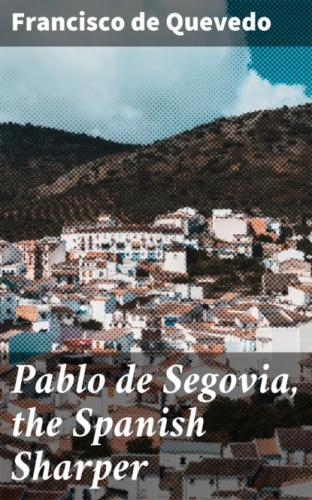Francisco de Quevedo
Pablo de Segovia, the Spanish Sharper
Published by Good Press, 2021
EAN 4057664575838
Table of Contents
COMMENTS ON THE DRAWINGS OF DANIEL URRABIETA VIERGE. And also a Letter from the Artist.
QUEVEDO AND HIS WORKS: With an Essay on the Picaresque Novel .
CHAP. I. Giving an Account of Who he is and Whence he Sprung.
CHAP. II. How I Went to School, and What Happened to me there.
CHAP. III. How I went to a Boarding School in quality of Servant to Don Diego Coronel.
CHAP. IV. Of my Convalescence, and Departure for the University of Alcalá de Henares.
CHAP. VI. Of the wicked old Housekeeper, and the first knavish pranks I played at Alcalá.
CHAP. IX. Of what Happened to me on the road to Madrid with a Poet.
CHAP. XII. Of my flight from Segovia, with what Happened to me by the Way to Madrid.
CHAP. I. Of what happened to me at my coming to Madrid as soon as I arrived there, until Nightfall.
CHAP. II. In which the same Subject is pursued, with other strange Incidents.
CHAP. V. How I took a Lodging, and the Misfortune that befel me therein.
CHAP. VI. In which the same Adventure is pursued, with various other Incidents.
CHAP. VII. In which the Story is continued, with other Incidents and notable Misfortunes.
CHAP. VIII. Of my Cure, and other Strange Things.
CHAP. IX. In which I turn Player, Poet, and Gallant of Nuns; which Characters are Daintily Painted.
CHAP. X. Of what happened to me at Seville, till I took Ship for the Indies.
COMMENTS ON THE DRAWINGS OF
DANIEL URRABIETA VIERGE.
And also a Letter from the Artist.
TO attempt to introduce Daniel Vierge to the few artists of the world who are artists, would be, on my part, an impertinence, since his work is as well known to them as it is to myself. To attempt to introduce him to the rest of the world would be no less impertinent, since apparently most men care nothing for the illustrator, though they may, without ever troubling to know him, delight in his work. But the appearance of Pablo de Segovia, not in French or Spanish, but in English, illustrated by Vierge’s completed series of drawings, is worthy of note and, possibly, of some comment.
Vierge’s first edition of this book was published in Paris in 1882, by Bonhoure, and the drawings not only made his own name famous throughout the entire artistic world, but renewed the popularity of Quevedo. The book—and when I speak of it I refer to the illustrations and not to the letter-press—was the most brilliant, the most daring, the most original which had ever appeared. From the head-piece of the first chapter nearly to the end, almost every page contained a perfect picture which amazed all who studied it, and delighted all who could appreciate it. These exquisite little drawings displayed a knowledge of form, of action, of light and shade, of architecture, expressed with a brilliancy of handling which has never been surpassed. To make such a statement is to challenge criticism. But if there have been any more artistic drawings, or engravings of drawings, produced from the time of Dürer or Bellini, Rembrandt or of Piranesi, I have yet to find them, though I have gone in search of them through the chief Museums and Galleries of Europe. In comparison with Vierge, Dürer knows nothing of light and shade, Bellini and Vandyke and Holbein are heavy and laboured in their handling, while Piranesi and Canaletto have but an historical interest. It is true that to-day in many ways by many men Vierge is nearly approached, but he has been the inspirer and the master of them all.
The ninety little process blocks in Bonhoure’s edition showed the knowledge of the past, combined with the brilliancy and go of the present. But after a certain page there came a blank, and the letter-press
